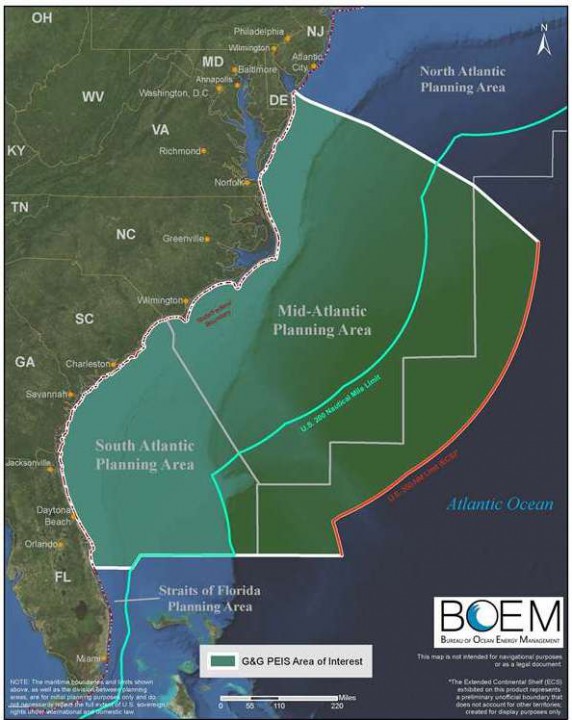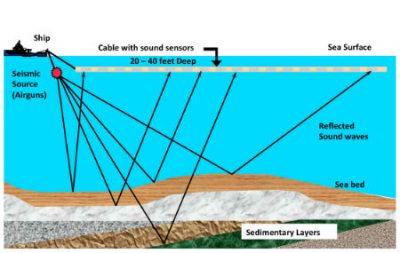Environmental groups are urging federal regulators to take a closer look at the effects of proposed seismic surveys to find oil and natural gas off the East Coast, saying the existing environmental study doesn’t reflect the best available science. They also claim that the the expected harm to marine mammals from the sound waves used in the tests has been grossly underestimated.
The Natural Resources Defense Council, or NRDC, in a 12-page letter also signed by the N.C. Coastal Federation, the Center for Biological Diversity, Earthjustice, the Southern Environmental Law Center and a dozen other groups, requests a supplemental environmental review of the proposed seismic surveys set to be conducted through 2020. The letter was emailed Monday to Gary Goeke, chief of the Environmental Assessment Section at the federal Bureau of Ocean Energy Management, or BOEM.
Supporter Spotlight
The environmental groups say BOEM’s environmental study “no longer provides a full and fair discussion of significant environmental impacts, informs decision-makers and the public, or adequately minimizes adverse impacts to the environment.”
The federal law requires that the latest information be considered, even when an environmental impact statement has been finalized. BOEM’s report was completed in March 2014.

“What we are seeing with this new research is significant, and has the potential to change the assumptions that BOEM originally made with the EIS from 2014,” said Ladd Bayliss, a coastal advocate with the N.C. Coastal Federation. “This new information has to be factored into the discussion, especially when considering the potential far-reaching and cumulative impacts of seven seismic surveys that could occur in the mid- and south-Atlantic regions.”
The federation and other groups say density estimates of marine mammals, all whale, dolphin and porpoise species, were too low in the study and outdated and inaccurate data were relied on to determine the zones of effect on marine mammals from the noise associated with seismic air gun blasts.
“In the mostly dark ocean environment, marine mammals depend on sound to find each other, breed, feed, navigate, and avoid predators—in short, for their survival and reproduction,” as described in the letter.
Supporter Spotlight
Since BOEM’s publication of the environmental study, at least two scientific studies have become available that bear directly on BOEM’s estimate of marine mammal impacts and the expected environmental effects of the proposed survey activity. The new studies include a January report by the Duke University Marine Geospatial Ecology Lab and a peer-reviewed paper published in September in Frontiers in Ecology and the Environment by researchers including Doug Nowacek, an associate professor at Duke.

Basic Assumptions
The new science focuses on two fundamental assumptions in the analysis of how seismic blasting will affect the marine environment, explained Michael Jasny, NRDC’s director of marine mammal protection.
“There is now new information about how many marine mammals will be in the water where seismic exploration is taking place and there is new information about at what point they will be significantly impacted,” he said. “The new science shows that not only did the agency get its answers to those questions wrong, it shows that in getting the answers wrong it grossly underestimated the scale of impact.”
Jasny said new information shows that marine mammals would be affected by seismic blasting as much as three times more frequently than BOEM had anticipated.
BOEM’s final environmental impact statement released in 2014 estimates that the planned seismic surveying activities in the Atlantic will result in as many as 138,000 injuries to marine mammals and in 13.5 million disturbances of marine mammals, including disruptions in vital behaviors such as feeding, mating and communicating.
“The new information indicates that BOEM may have underestimated the number of impacts by a factor of 15 or more,” Jasny said.

Part of the difference is BOEM’s estimate of marine mammal density in the survey areas and the estimates in more recent studies, but also at play is the area of ocean that would be affected by the blasting.
“BOEM, in trying to determine the area of impact, drew a circle around each air gun array but the science is showing the circles they drew are far too small,” Jasny said.
The estimated area of impact is roughly five to 15 kilometers around each air gun array, in BOEM’s report. New science indicates at least some species, such as baleen whales, are affected at distances of hundreds of kilometers from the arrays.
“Multiple studies are showing that air guns silence baleen whales, impacting behavior vital to their feeding, breeding and migration at distances far from the area. BOEM drew its circles far too tightly around the ships. In so doing, it interpreted an activity that really alters a fundamental aspect of the marine environment over very large areas of water space, indeed over much of the region where industry would be operating. That’s no longer tenable scientifically,” Jasny said.
The main flaw is that the bureau had relied on studies done in the 1980s that became the standard for determining impacts through the late 1990s. Jasny said that’s “practically the stone age” as far as ocean research is concerned.
“There has been a flood of important science that extends far beyond the limited perspective of what was available in the early 1980s when those studies were done,” Jasny said. “As the authors of one study put it, the study that BOEM relies upon is outdated and inaccurate.”
Determining at what point mammals are affected is fundamental to the process, Jasny said.
“BOEM has an obligation under federal law, to supplement its environmental impact statement to reflect the new science,” Jasny said. “Otherwise it will have in effect analyzed the wrong activity, and its assessment of impacts and its considerations of alternatives will be out of proportion with what science is telling us are the likely effects.”
‘Significant, Long-lasting, Widespread’
In March, ocean scientists from around the world sent a letter to President Obama urging a halt to planned oil and gas exploration program off the Atlantic coast because of the “significant, long-lasting and widespread impacts on the reproduction and survival” of threatened whales and commercial fish populations. In the letter to the president, the 75 scientists from Cornell, Duke, the New England Aquarium, Stanford, the University of North Carolina and other U.S. and international institutions said that the seismic blasts, from high-volume air guns that fire every 10-12 seconds, are nearly as loud as conventional explosives and have “an enormous environmental footprint.”
The letter was the first time a group of prominent scientists had said that the harm from seismic blasting would be significant and long-lasting for entire populations of marine life off the U.S. coasts.
“They said that without revision, changing the EIS, it would be simply unsustainable. Science that has emerged since March only confirms those concerns,” Jasny said.

Some of the scientific work was overdue, including marine mammal density studies begun several years ago that were anticipated by the scientific and environmental communities.
The “area of interest” studied in the environmental review is home to 39 species of marine mammals including six endangered species, the North Atlantic right whale; blue whale; fin whale; sei whale; humpback whale; and sperm whale. The government’s new modeling shows far greater population densities than BOEM anticipated.
BOEM acknowledges marine mammals have the greatest vulnerability to seismic air gun surveys and BOEM’s report recognized that when this new density information was produced, it would become the best available science and would require revision of the environmental analysis.
“What’s new is a summary of an analysis of those recent papers and synthesis of those recent papers, culminating in the clear conclusions,” Jasny said. “The standard BOEM has been using is simply wrong.”
Noise Travels
The BOEM study sets a threshold for risk to marine mammals at 160 decibels. New science indicates a much lower threshold, centered at 140 decibels. Because of the way noise travels through water 20 decibels is a huge difference.
“The difference is logarithmic,” Jasny said. “A 10-decibel increase represents a tenfold increase in acoustic intensity. It’s like the Richter Scale, as you go up, you’re multiplying, not adding.”
He said the resulting environmental footprint of all proposed seismic blasting would be like a small town affecting an area the size of a state.
“According to BOEM’s EIS and judging by the applications received, you’re likely to have multiple arrays active at any given time and the amount of water covered by each of these surveys is enormous. The three applications presently pending represent more than 90,000 miles of survey lines. That’s significantly long-lasting and widespread,” Jasny said.







